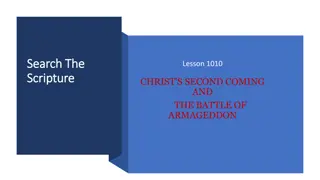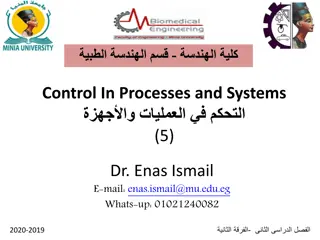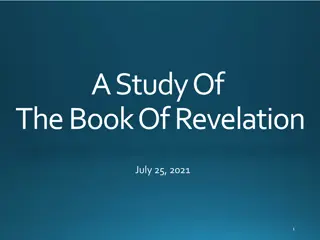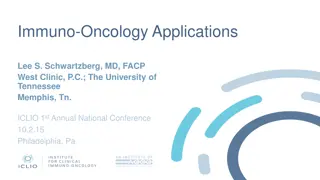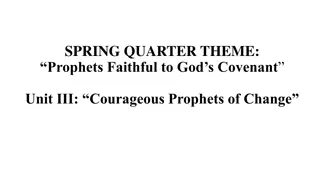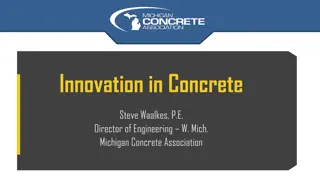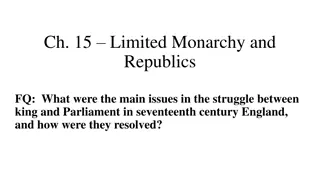The Faithful Struggle: A Journey Through Contrasting Responses in the 1890s and Early 1900s
The 1890s brought about a clash between skepticism and faith, leading to revivals, conversions, and challenges within the church. As the new century dawned, the battle between righteousness and unbelief intensified, prompting calls for repentance and deeper spiritual commitment. Key events, like Ellen White's return from Australia and shifts in the church's leadership structure, shaped the trajectory of Seventh-day Adventism. The narrative unfolds with an underlying theme of perseverance amidst adversity and the continuous pursuit of truth and righteousness.
Download Presentation

Please find below an Image/Link to download the presentation.
The content on the website is provided AS IS for your information and personal use only. It may not be sold, licensed, or shared on other websites without obtaining consent from the author.If you encounter any issues during the download, it is possible that the publisher has removed the file from their server.
You are allowed to download the files provided on this website for personal or commercial use, subject to the condition that they are used lawfully. All files are the property of their respective owners.
The content on the website is provided AS IS for your information and personal use only. It may not be sold, licensed, or shared on other websites without obtaining consent from the author.
E N D
Presentation Transcript
RIGHTEOUSNESS COUNTERFEITED: FOUNDATIONS SHAKEN CHRIST OUR RIGHTEOUSNESS: 5 FRED BISCHOFF WWW.FREDBISCHOFF.COM WWW.APLIB.ORG
REVIEW 1890s was a decade of contrasting responses to the message of the faith of Jesus, stories of His unselfish love motivating revivals, conversions, missionary exploits, and physical healings, alongside continued unbelief and its root of selfishness, with their results backsliding, compromise, failure to walk in the light, ego battles. Mrs. Henry s story appears to show what could have been, and the closing of a window of opportunity.
PREVIEW The early years of the 1900s will show the immediate results in confusion and disasters, while the global outreach of the church continues to expand! The battle between righteousness and unbelief, in the life and ministries of the church continues, with calls for deeper repentance.
1900 September: Ellen White returns from Australia; shortly purchases Elmshaven home. (Ellen G. White, Biography Volume 5, page 26.1; 34.3) (See the syllabus for more study on intriguing statements of the importance of global events at the beginning of the Twentieth Century.)
1901 April: At the General Conference Session Ellen White addresses both unbelief and rebellion, notwithstanding the numeric growth and world-wide expansion of the church in the 1890's under the spirit of the Loud Cry message. Light of the past 10 years assented to but elements of unbelief prevented light from being acted upon (General Conference Bulletin, April 3, 1901 paragraphs 1-3, 12; entire speech is very important; see also Entry of Seventh-day Adventists into World Countries in Reference section).
1901 At the same General Conference Session W. W. Prescott confesses the continuing opposition to the Minneapolis message (13 years), and calls for repentance (Ibid., April 18, 1901, page 321.3-7). The organizational structure of the church is changed by adding Union Conferences and removing the position of General Conference president. (See Ellen G. White, Biography Volume 5, page 91.4; 95.6.) Will the track of Romanism be rejected successfully?
1901 The college is moved from Battle Creek to Berrien Springs by E. A. Sutherland and P. T. Magan and renamed Emmanuel Missionary College. (Recalled two years later: General Conference Bulletin, April 6, 1903 par. 3, in "Our Duty to Leave Battle Creek. ) Magan almost dies of typhoid fever, and writes to Ellen White in discouragement (For God and CME, Merlin Neff, p. 92).
1901 She replies to encourage him, and to explain the insubordination behind the opposition to the work of applying gospel principles to education (educational reform). In that context she projected the possibility of a DELAY of the mission of Adventism "many more years (Lt. 184, 1901; in Manuscript Releases, Volume 20, page 312.7; 313.1). What will happen to the ministries remaining in Battle Creek?
1901 September 5: The theme of repentance in the messages to the churches in Revelation is applied in a pervasive sense, in a talk to church school teachers. The life we live is to be one of continual repentance and humility. We need to repent constantly, that we may be constantly victorious. When we have true humility, we have victory. (SDA Bible Commentary, Volume 7, page 959.9, 960.2; complete in Manuscript 92, 1901, paragraphs 6 & 8.)
1902 February 5: Need for the old hands, the aged workers ; many have fallen asleep in Jesus ; greatly appreciate the help of those who are left alive (Lt. 47, 1902; in Ibid., page 219.3&4) The importance is increasing of the early eyewitnesses of God s leading and teaching.
1902 February 18: The Battle Creek Sanitarium burns down, with the loss of just one life (Ellen G. White, Biography Volume 5, page 148.1-3; 150.1). Ellen White recalled Kellogg s earlier thoughts of continuing the work of reform in the very planning, location and operation of our flagship health institution (in harmony with the work of justification by faith applied to the health work addressed to Dr. Maxson October 12, 1896). But this direction is abandoned as he plans an even bigger temple of truth in that same location (Ibid., pages 151.6 to 152.2).
1902 July 7: Ellen White writes E. J. Waggoner, regarding the importance of understanding and presenting the book of Revelation. "No one mind can do this work alone. Although we have in trust the grandest and most important truth ever presented to the world, we are only babes, as far as understanding truth in all its bearings is concerned . The theme of greatest importance is the third angel's message, embracing the messages of the first and second angels.
1902 All should understand the truths contained in these messages and demonstrate them in daily life, for this is essential to salvation. We shall have to study earnestly, prayerfully, in order to understand these grand truths; and our power to learn and comprehend will be taxed to the utmost." (Lt. 97, 1902; in Manuscript Releases, Volume 12, page 212.3). (Note how intensely practical the message and mission are.)
1902 December 30: The Review and Herald Publishing House burns down (Ellen G. White, Biography Volume 5, page 223.1-3). The sword of fire had continued its work in Battle Creek due to the failure to walk the path of repentance. The plates for Loughborough s 1892 book The Rise and Progress of Seventh- day Adventists are destroyed. What is the response of institutions and individuals to these disasters? The publishing work would not be rebuilt in Battle Creek.
1902 Elmshaven writing room is added. (Ellen G. White, Biography Volume 5, page 185.5)
1903 January 1: Ellen White writes "What Might Have Been" regarding 1901 GC Session--"a Pentecostal season that failed to occur. (Testimonies for the Church, Volume 8, page 104.1, following) January 14: Ellen White writes that the 1901 GC Session was "the greatest, the most terrible, sorrow of my life. No change was made." (Lt. 17, 1903; in Manuscript Releases, Volume 13, page 122.3). Uriah Smith dies
1903 March 30: If people of God had obeyed His word , would today be in the heavenly Canaan (General Conference Bulletin, March 30, 1903, paragraph 25; DELAY)
1903 April 3: God does not endorse the efforts put forth by different ones to make the work of Dr. Kellogg as hard as possible, in order to build themselves up. God gave the light on health reform, and those who rejected it rejected God. One and another who knew better said that it all came from Dr. Kellogg, and they made war upon him. This had a bad influence on the doctor. He put on the coat of irritation and retaliation. (Ibid., April 6, 1903, paragraph 24)
1903 April 14: Need for the gray-haired pioneers to stand in their place in His work to-day (Ibid., April 14, 1903, paragraph 38)
1903 June 1: Need to do as the Lord directed Moses to do , to rehearse ... all the dealing of the Lord ; the early history of our work must be republished. Many of those who have since come into the truth are ignorant of the way in which the Lord wrought.
1903 The experience of William Miller and his associates, of Captain Joseph Bates, and of other pioneers in the Advent message, should be kept before our people. Elder Loughborough's book should receive attention. Our leading men should see what can be done for the circulation of this book." (Lt. 105, 1903; in Manuscript Releases, Volume 17, page 344.3&4). Loughborough s book is the 1892 edition of his history of the movement, no longer able to be reprinted.
1903 October 2: Ellen White writes first of five documents addressing the danger of free love, in a letter to E. J. Waggoner. (Lt. 230, 1903; in Manuscript Releases, Volume 21, page 172.3. See syllabus for further study on this counterfeit of God s unselfish love which comprises His righteousness.)
1903 J. H. Kellogg publishes his book The Living Temple in spite of opposition by the General Conference due to the spiritualism/pantheism concepts in it (Ellen G. White, Biography Volume 5, pages 290.2 to 294.1).
1903 October 22: In regard to Kellogg s book Ellen White writes, We need not the mysticism that is in this book. Those who entertain these sophistries will soon find themselves in a position where the enemy can talk with them, and lead them away from God. It is represented to me that the writer of this book is on a false track. He has lost sight of the distinguishing truths for this time. He knows not whither his steps are tending.
1903 The track of truth lies close beside the track of error, and both tracks may seem to be one to minds which are not worked by the Holy Spirit, and which, therefore, are not quick to discern the difference between truth and error. (Review and Herald, October 22, 1903 paragraph 2, in "Teach the Word . See syllabus for more study on Ellen White s use of words related to mystical . See also the story of William Sadler.)
1903 The initial opposition to the Loud Cry message was based on a false charge that it was undermining the landmarks (Ms. 13, 1889; in EGW1888, pages 518, 519). In the confusion that followed that misled opposition, by 1903-1905 the sanctuary landmark is under attack by A. F. Ballenger and J. H. Kellogg. (See Manuscript Release, Number 760, especially pages 4.4, 8.3, 10.2, 14.2, 15.2&3, 21.1, 23.3.) Peak year for number of EGW letters and manuscripts = 472. (See Ellen White s Writing History under Reference section.)
SUMMARY OF 1900-1903 The need for the work of repentance and reformation reached a critical point at the heart of the work in Battle Creek. The work of scattering the ministries from Battle Creek began in a voluntary move of the college. The burning of the sanitarium and hospital is followed by plans for a bigger facility in the same location. What will its future be? The publishing work will be moved.
THOUGHT QUESTION What forces are attempting to shake you off the foundations?




